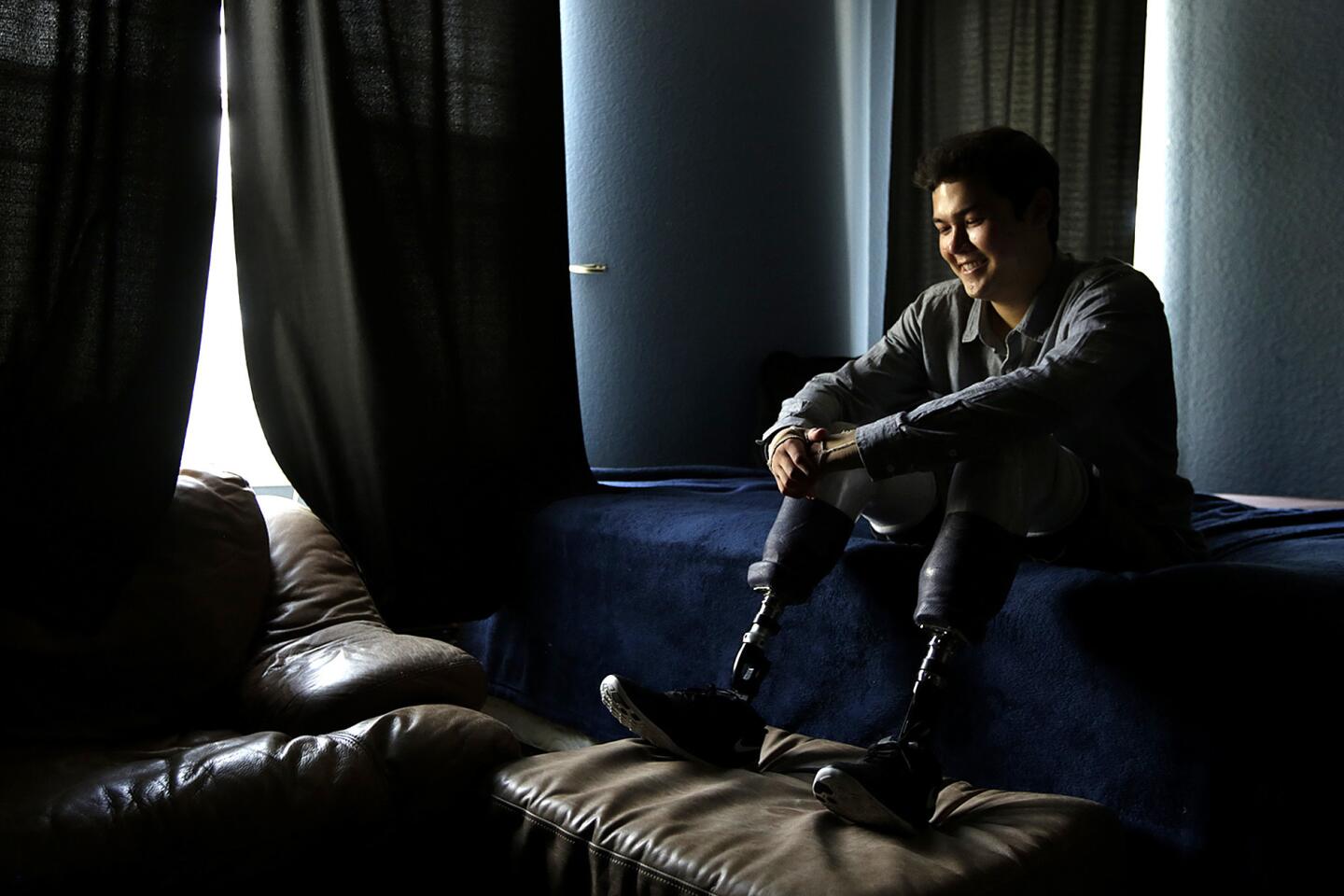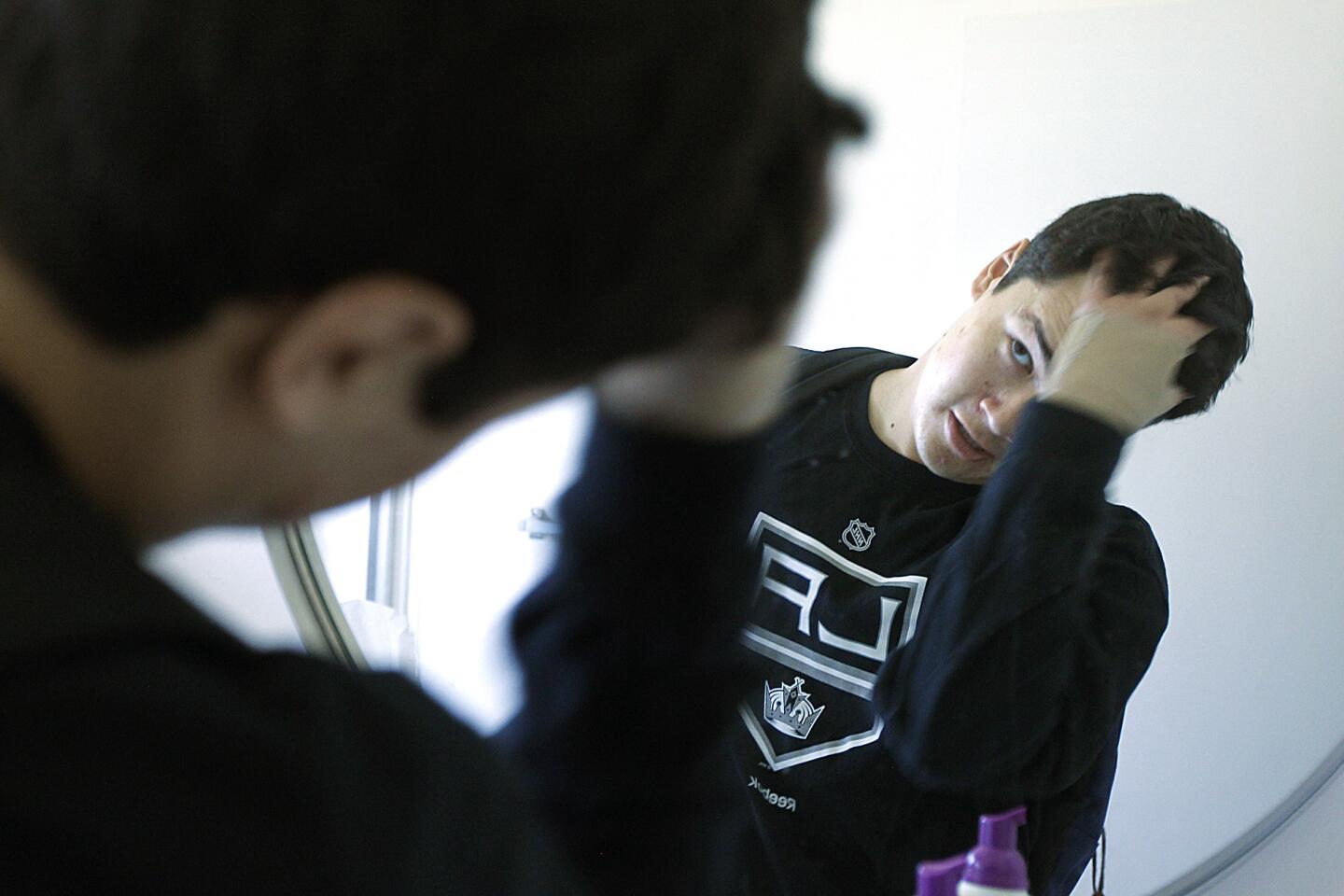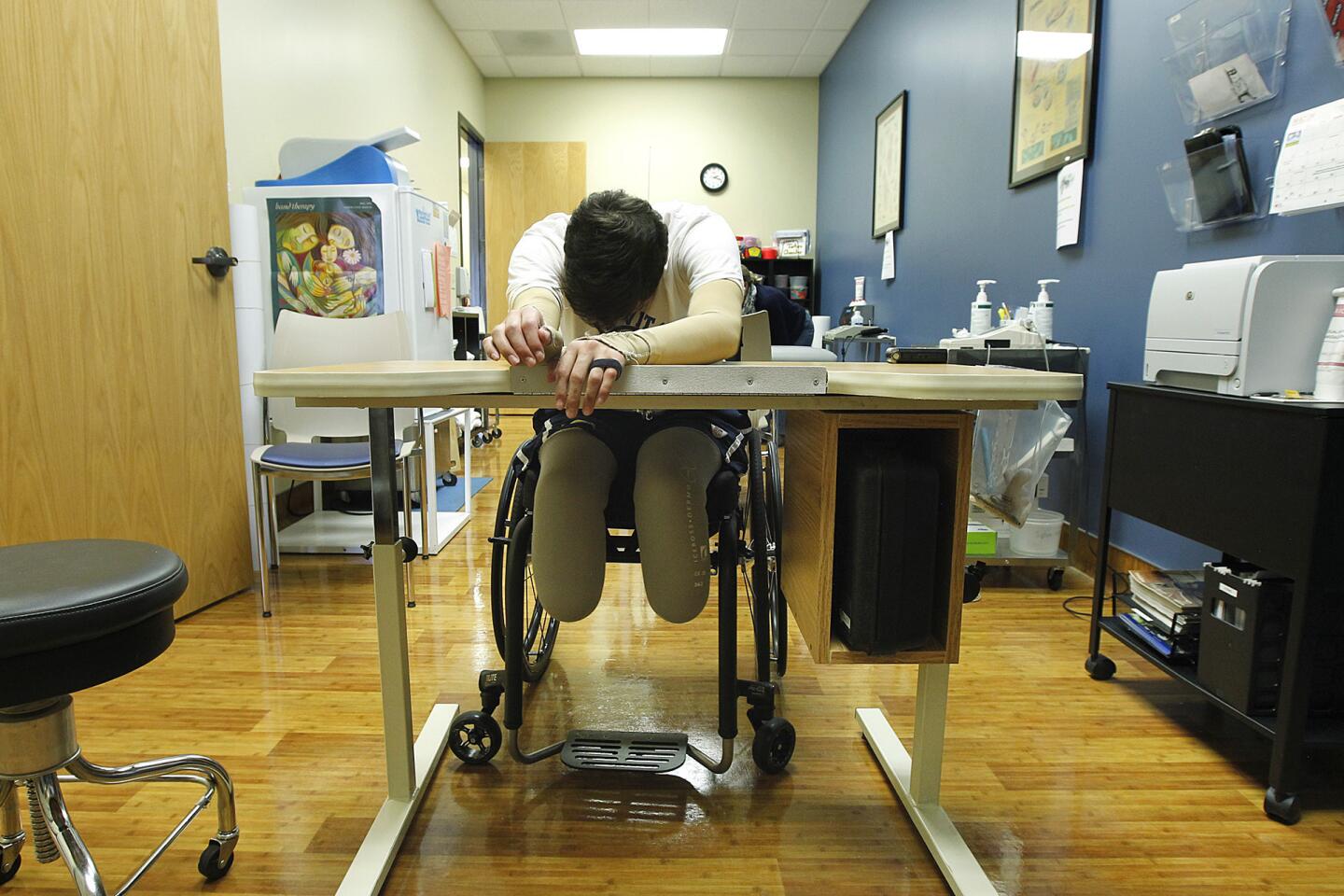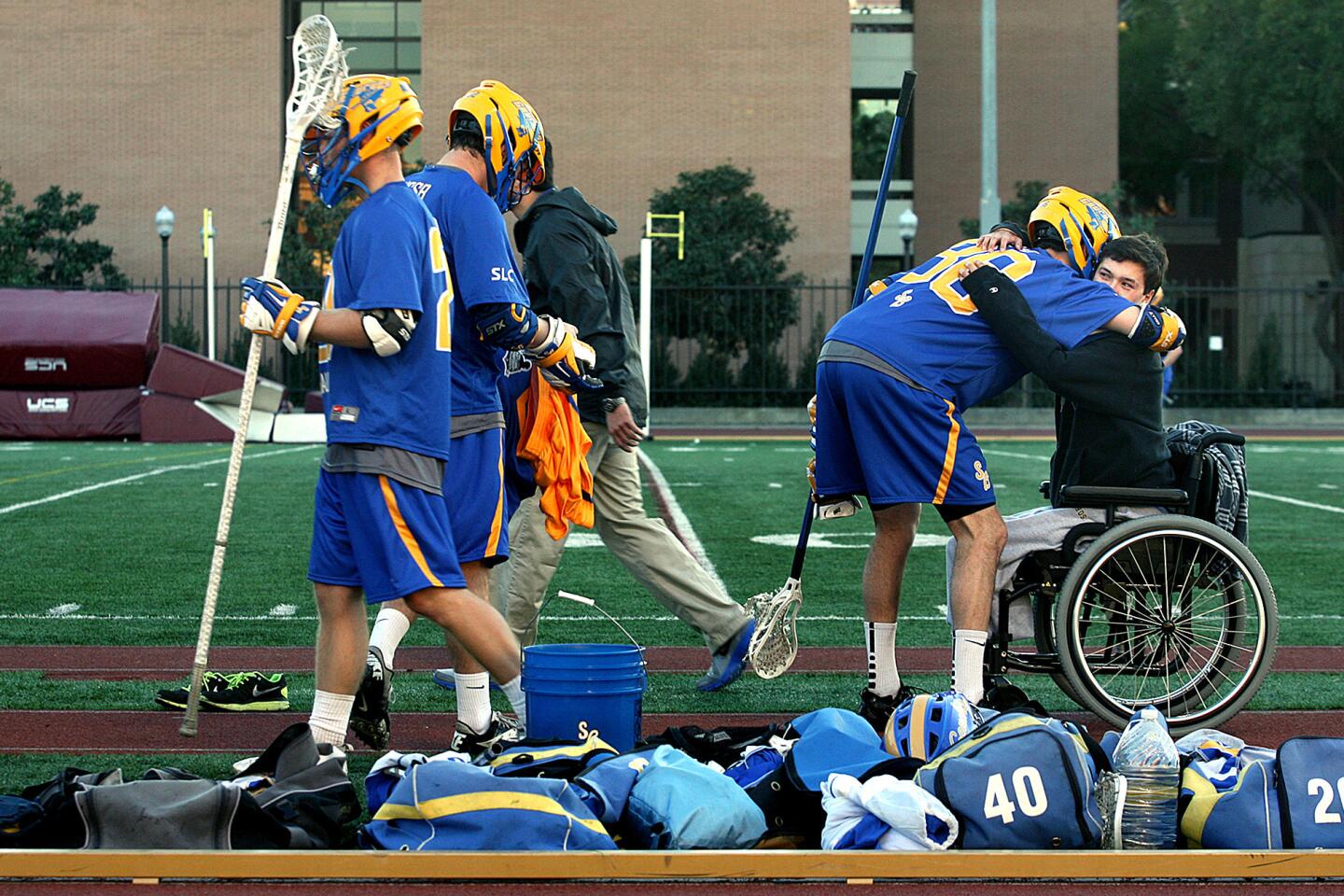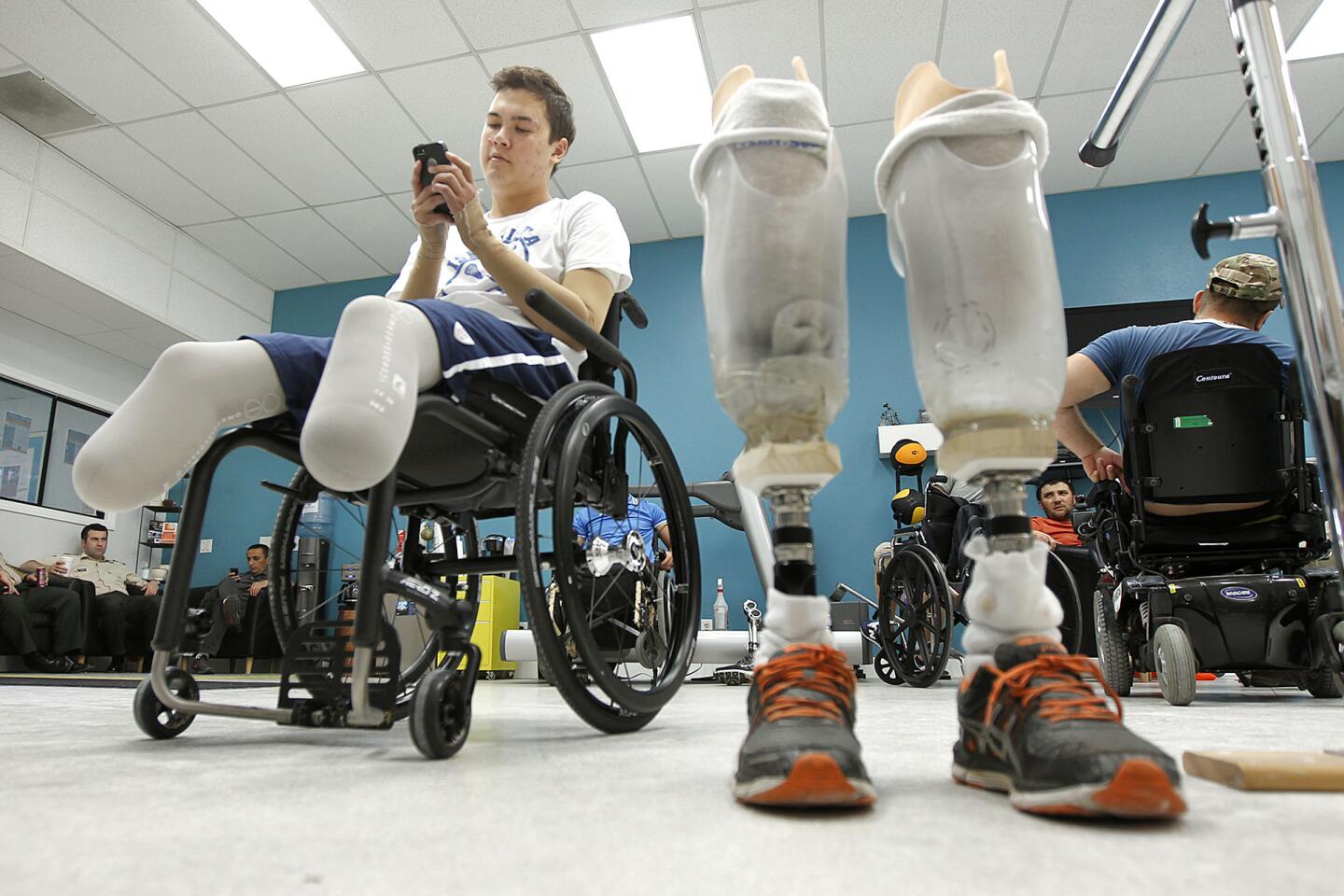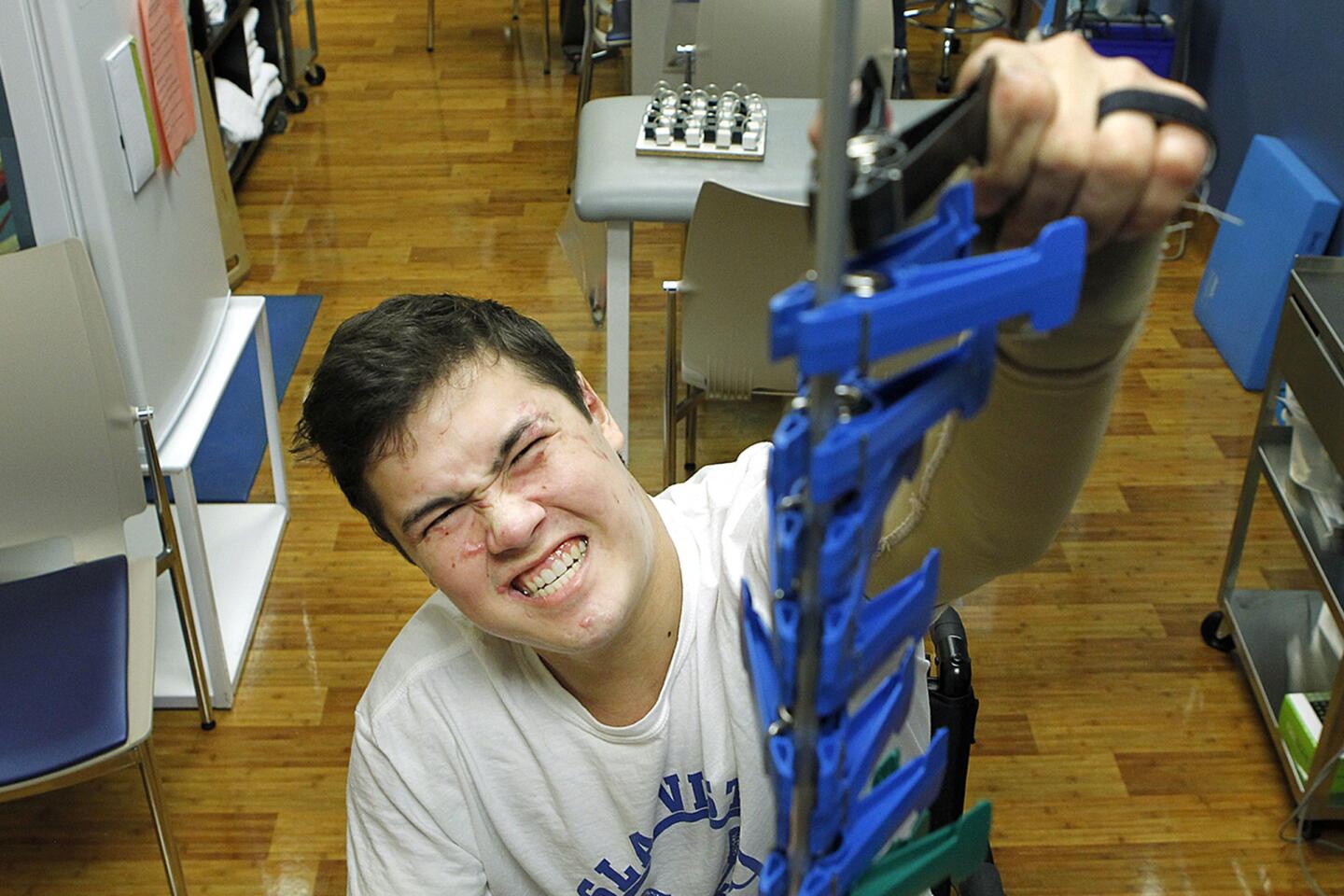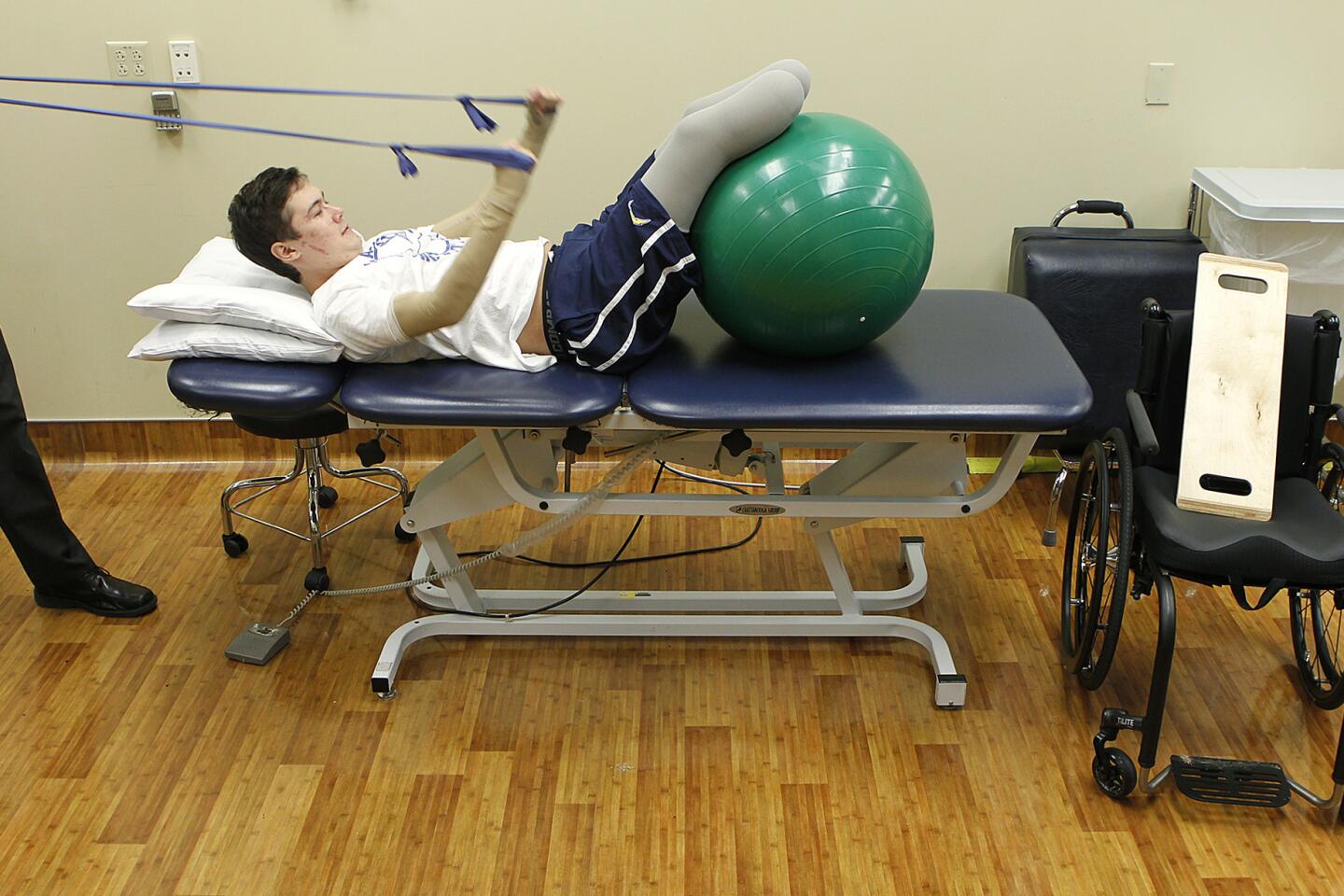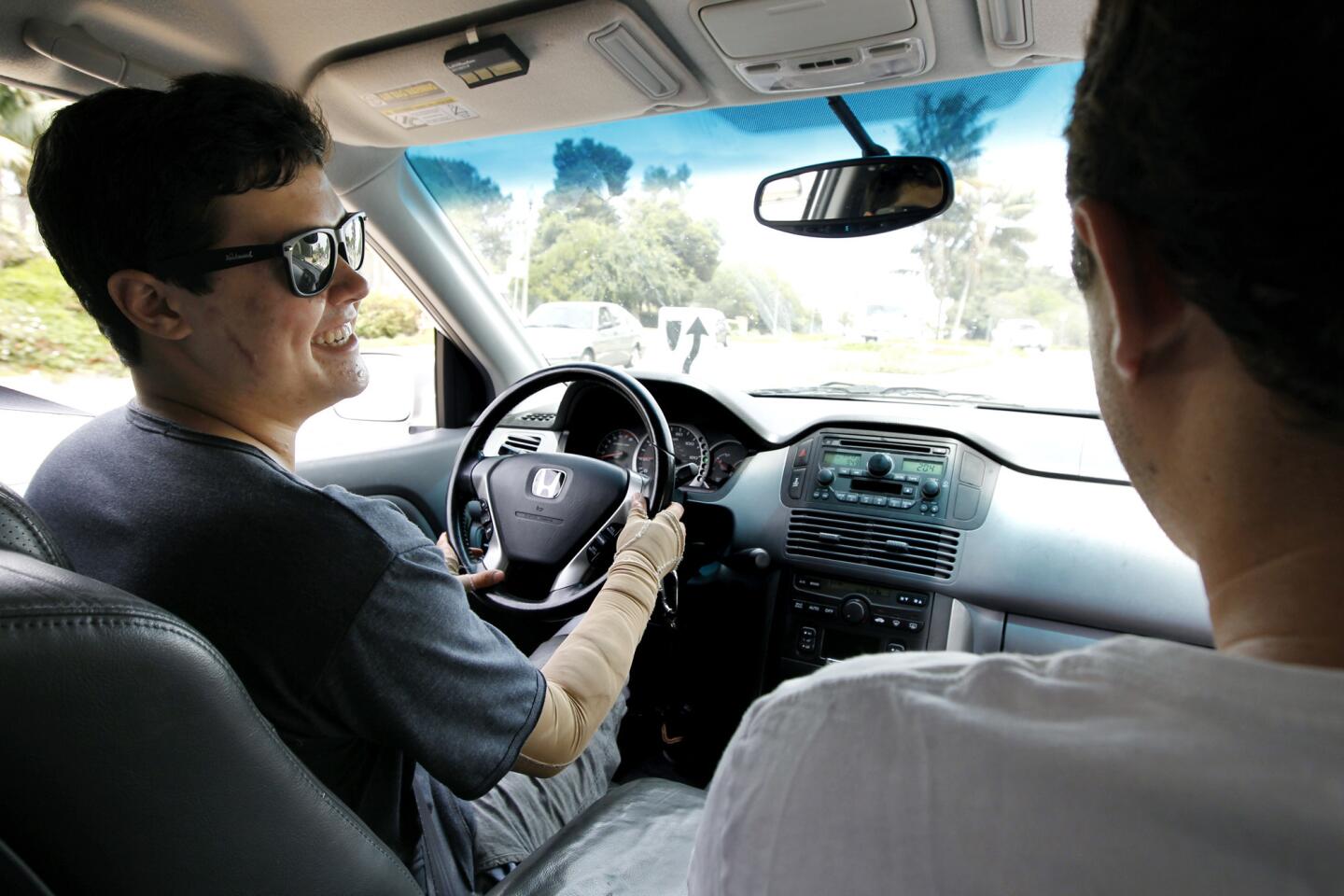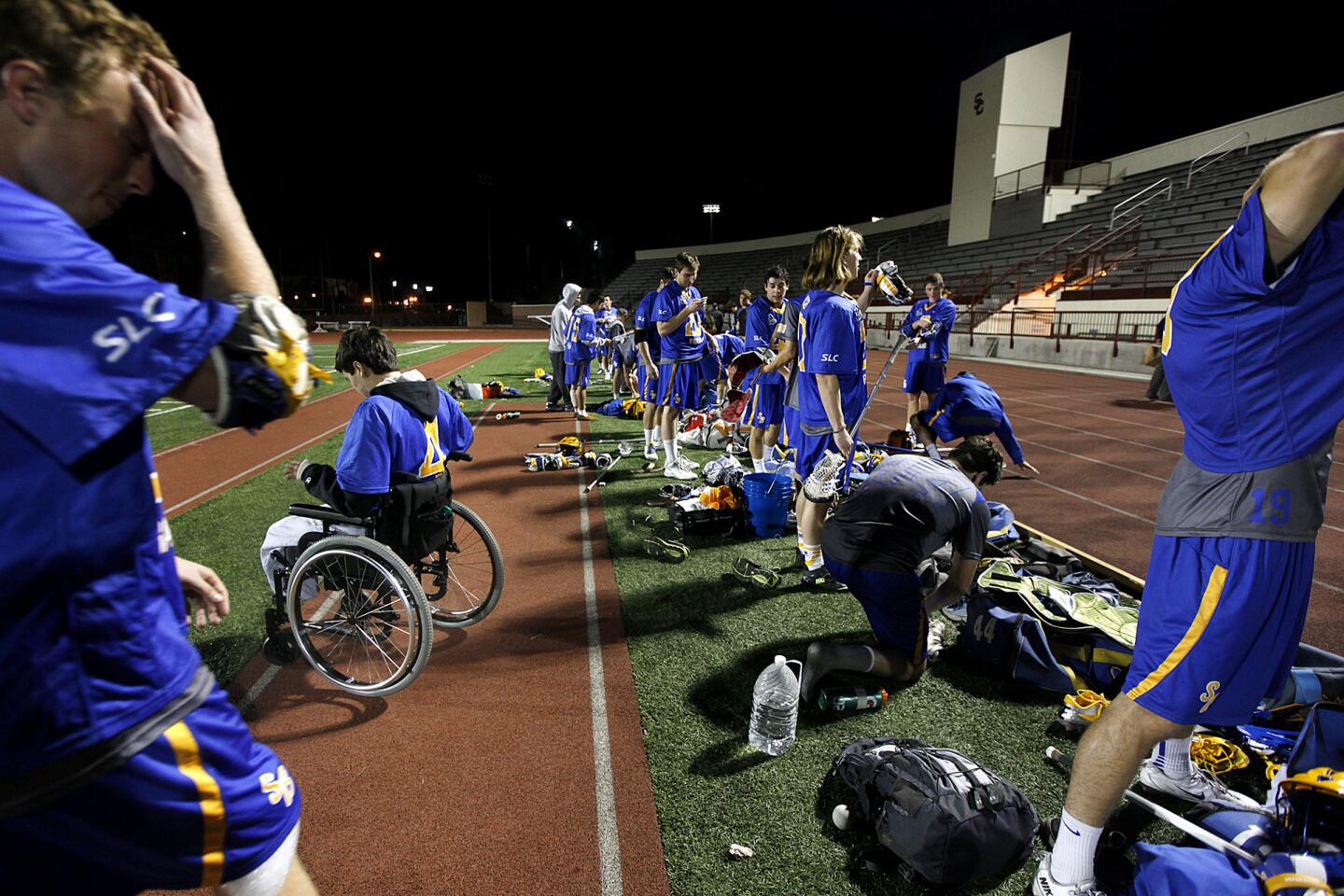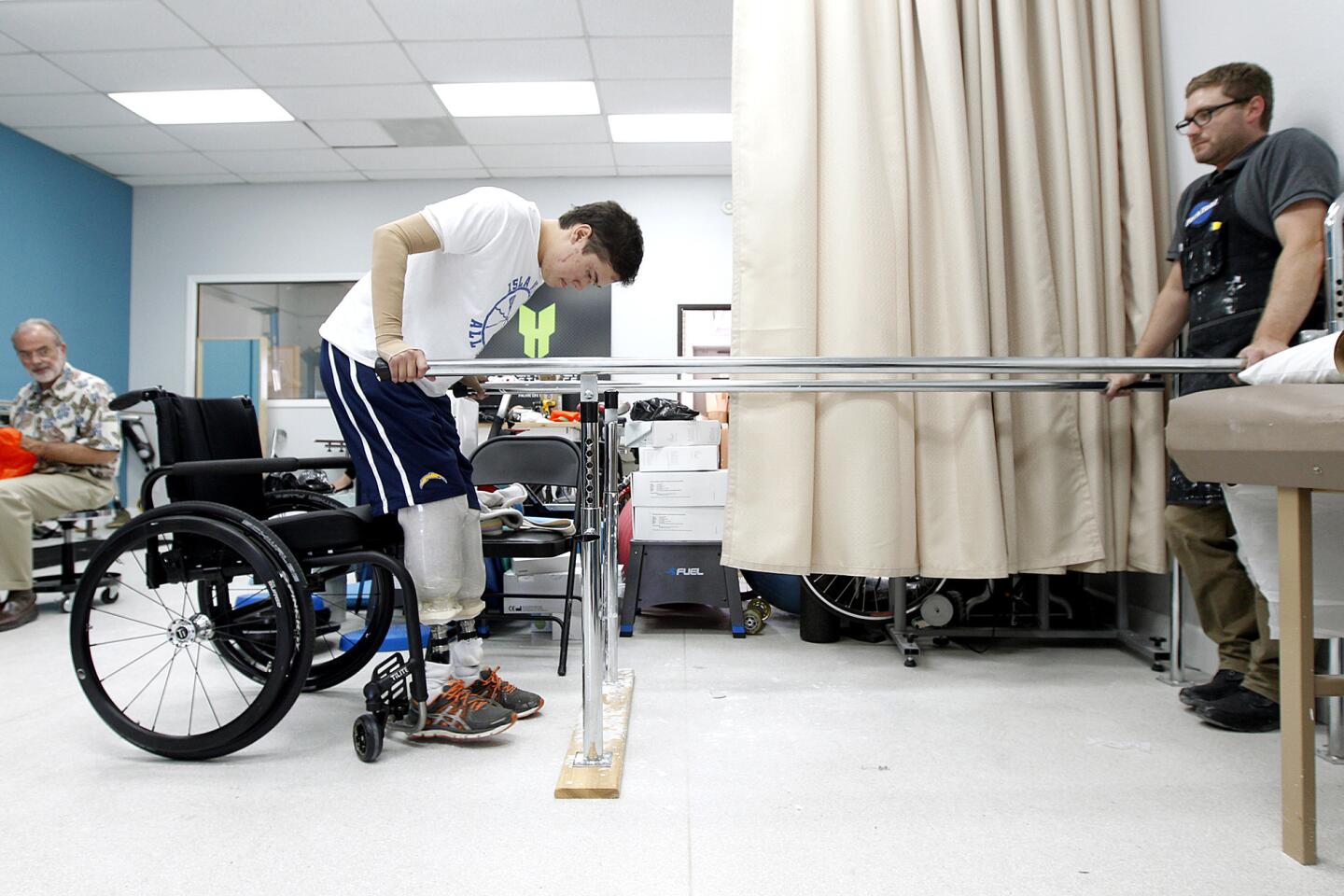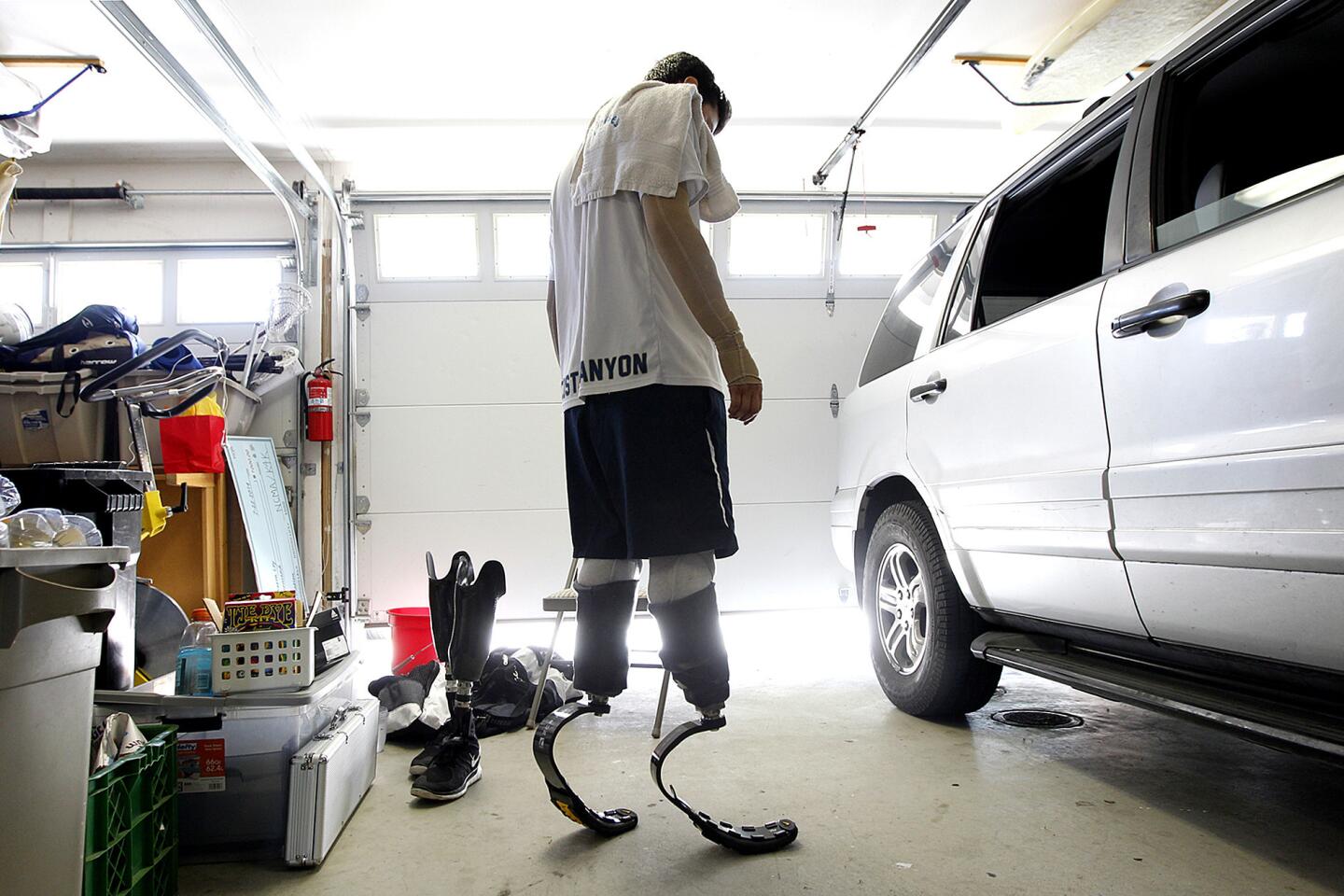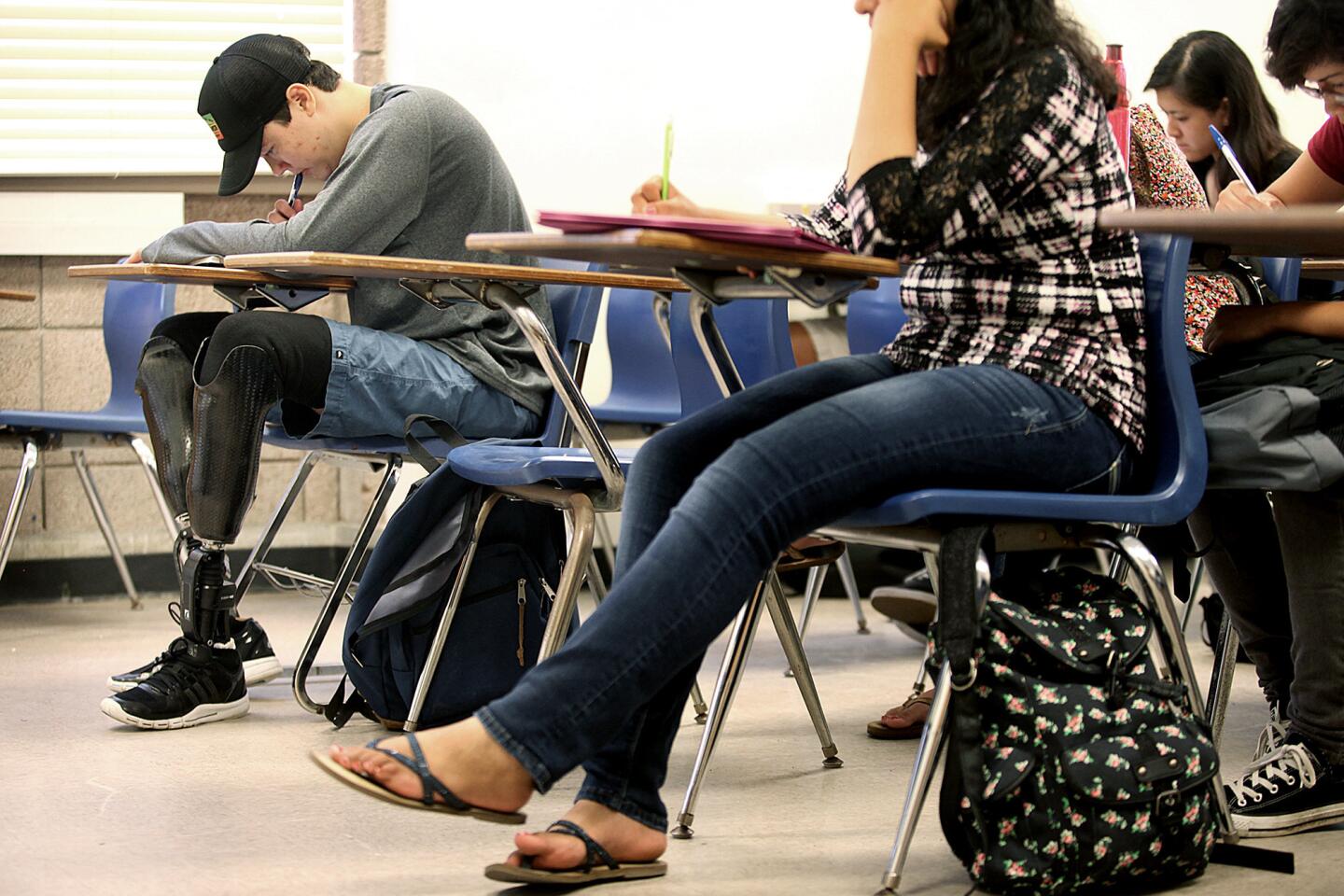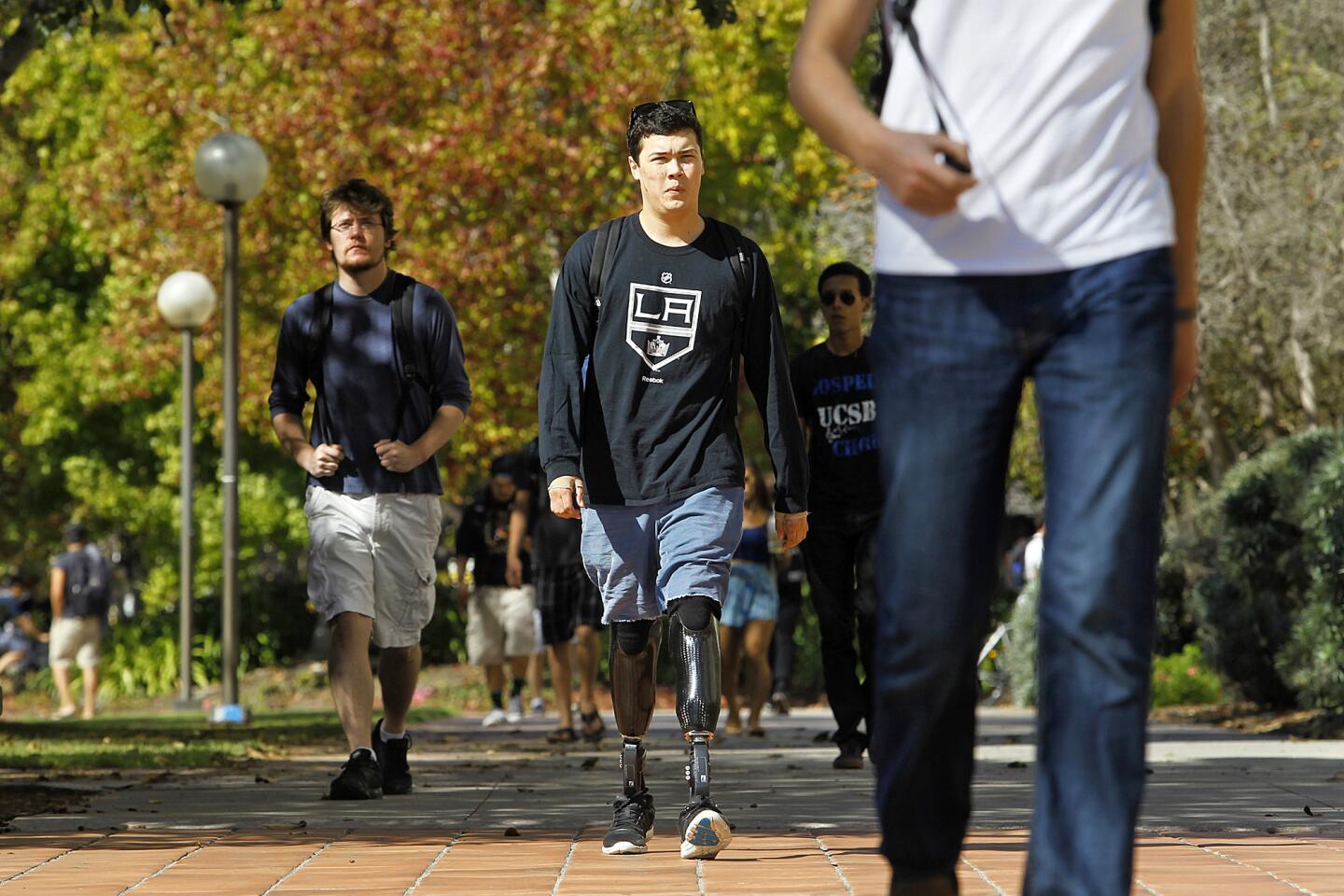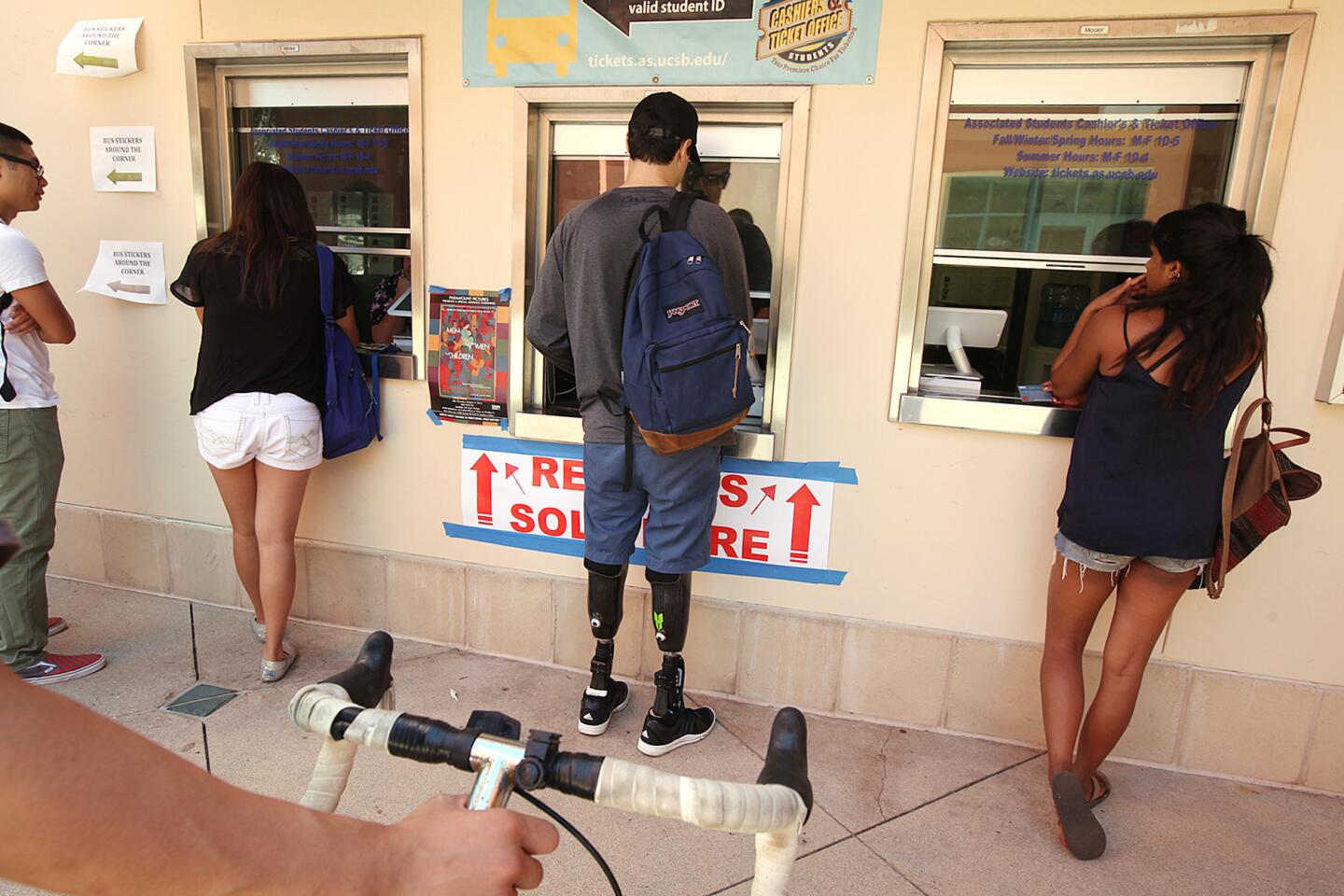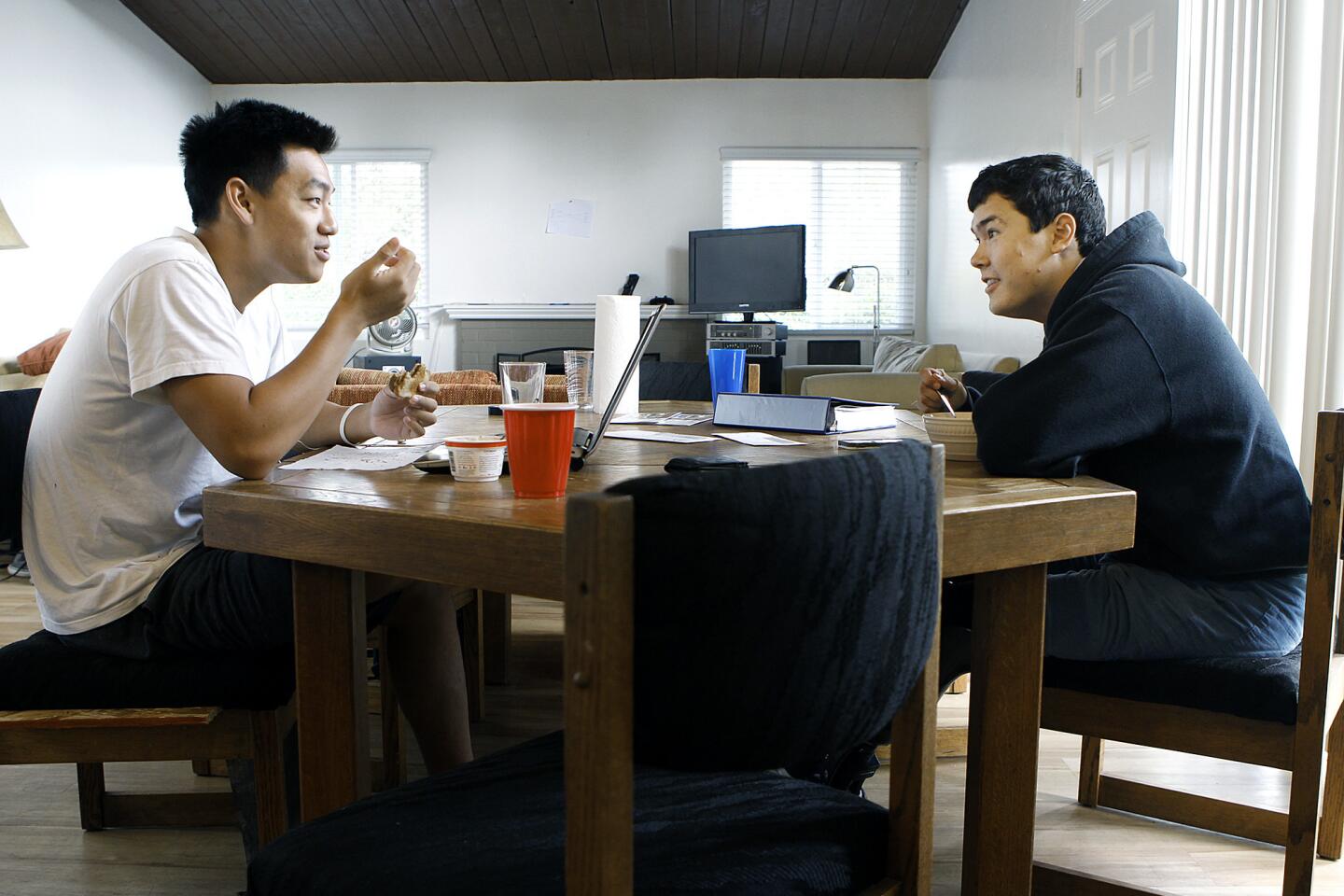Great Read: A college athlete beaten back by meningitis reclaims his life
- Share via
Aaron Loy sat on his surfboard, bobbing in the flat Pacific, waiting for a wave.
It was an unusually light day seven weeks into his freshman year at UC Santa Barbara — no classes, no lacrosse team practice and only a bit of homework for later. So he and a buddy decided to take in the November sun at the beach.
The waves never came, so Aaron pedaled his bike barefoot along the cliffs into Isla Vista and back to his dorm room.
He felt tired but started on his calculus homework. The room was cold, so he threw on a sweater. Then another. Then another. He put on a beanie and gloves and slipped under the covers of his bed.
His sweat soaked into his sheets, yet he was still so cold. He thought about calling his mom but decided not to — it was probably just the flu.
A friend from down the hall found him the next morning, shivering and barely responsive. The friend’s mother was a nurse, so he sent a photo of Aaron to her. She told them to go straight to the emergency room.
They dragged him out into a bright morning at UC Santa Barbara as students on bikes whizzed by on their way to campus. They pulled Aaron into the back seat and sped south on the 101 to the hospital.
::
In San Diego, Kirsten Loy’s phone buzzed and rattled inside of her purse, interrupting her sixth-grade history lesson. She finally decided to answer it. The voice on the other end said he was a nurse.
“You need to drop everything and get to the hospital right now — your son is very ill,” he said.
“What?” she asked. She was in the middle of class and three hours away. “Is he OK?”
“He has meningitis,” the nurse said. “Leave now.”
Type B meningococcal disease thrives in close quarters. The bacterium attacks swiftly and can be spread by close contact — a cough, a kiss, a shared glass. It inflames the membranes protecting the brain and the spine. It can kill within hours.
Three other UCSB students were infected in the 2013 outbreak. All recovered.
The infection ravaged Aaron’s body. His brain swelled against his skull, and his blood turned to poison. His kidneys almost failed. In a cruel paradox, his blood both clotted and seeped uncontrollably. Purple blotches spread like spilled paint under his skin.
He was airlifted to a San Diego hospital. Aaron’s sister, Lindsey, flew in from college in Maine. Kirsten walked the halls holding a photograph to show nurses what her son really looked like — a strong, handsome athlete.
“He’s our golden boy,” she said.
The blood clots stopped the flow of oxygen to his feet, and infected tissue began to overtake them. They were soon beyond saving. Doctors knew if the infection continued to creep up his body, he’d be dead within days.
To save his life, they took his legs.
::
In the highlight tape, Aaron dashes down the sideline with the ball, into rival Torrey Pines High territory, a defender on his tail.
“Here comes Loy,” the announcer says.
The 2012 CIF San Diego Section Lacrosse Championship game has gone into overtime, and Aaron is making a run toward the goal. Two defenders rush toward him from either side; he ducks between them as they slash at him with their sticks before crashing into each other.
“Wheeling and dealing …”
It’s now he and the goalie. He skids and lifts his stick. The goalie rises, but Aaron slings the ball downward, and it bounces into the net as he barrel-rolls on the ground. Game over.
“The Mavericks are champions! The Mavericks are champions!”
::
Kirsten hopped out and popped the trunk, assembling the wheelchair as Aaron watched from the passenger seat. As she pushed the wheelchair alongside the door, Aaron bridged the gap with a wooden plank and shimmied onto it and into the chair. His legs, amputated just below the knee, swung back and forth.
It was time for his physical therapy appointment.
After lifting weights, he was off to hand therapy. His frail fingers, with patches of pink, were skinny and scarred. He slid them into plastic loops strapped to blocks stuck to a checkerboard of Velcro. He grimaced and growled as he ripped them upward.
The helplessness ate at him.
“I earned my freedom, and I got to live the life I earned for, like, two months,” he said. “Now, they have to bathe me, dress me, feed me, help me in and out of my chair.”
He had been a regular freshman, making the rounds of parties on Del Playa Drive on weekends, hanging out with new friends at the dorm — the same one where his parents met as freshmen.
“Imagine being an 18-year-old and stripped of everything,” he said. “Even your own body.”
Some mornings he awoke and it took a moment to remember. Then he would stay in bed and cry — until he realized the futility in lying there defeated.
“After a couple of minutes I think, what am I doing?” he said. “This isn’t going to get me anywhere.”
::
Aaron rolled his wheelchair down the track at Cromwell Field on the USC campus, where the UC Santa Barbara Gauchos were taking on the Trojans on a cold February evening.
As he approached the sideline, one teammate turned and started the chorus. “Yeah, Loy! What up, Loy!” Aaron beamed. The visiting crowd, mostly parents, broke into applause. One by one, each player sneaked off from the huddle to give him a hug. Someone gave him a jersey with the number 4 — his number. He slipped it on over his hoodie.
It would have been his first collegiate game.
He cheered as UCSB dominated the first half. At halftime, the team ran off to one end of the field, and another injured player pushed Aaron into the circle of players taking a knee.
As Coach Mike Allan went over halftime adjustments, Aaron’s eyes darted from his coach to the sky, to the crowd, then to the ground and back to the coach.
“OK, let’s go.”
The Gauchos added to their big lead. After the final whistle, the families and team gathered on the field, Aaron laughing and smiling and posing for photos.
Almost always facing the world with a smile, Aaron rarely shares the grief, or the sadness, whatever it is he feels. His closest friends and family know, but most see only the milestones of his recovery.
“People only see my highlight reel,” he said. “If I post something on Facebook or Twitter of me walking, something like that, those are only the highlights.
“They don’t see the end of the day when my legs are beat to crap and I’m tired and exhausted.”
But he was determined. He would walk again. And more: He’d drive again, ride his bike again, snowboard again. He’d go on that surfing trip to Indonesia with his friends someday. And he would be back in school in the fall. There on the first day of the next school year.
But first, he had to learn to walk.
::
The veteran injured in Afghanistan used his only remaining limb to push down on a cane and lift himself up from the wheelchair. The young man bobbed back and forth on his prosthetic legs, caught his balance and stood in place, lifting the cane off the floor.
Half a dozen other veterans tried on their new legs and arms. One man, with both legs amputated just below his hips, strode forcefully on his long titanium legs. Another did wheelies with his wheelchair.
Aaron watched the men, some only a few years older than he, then eased his own leg into the socket of his new prosthetic. He braced and lifted himself off the wheelchair. “It’s like I’m on stilts,” he said.
Each step was echoed by the wince of his mother, whose face suggested both terror and pride. She beamed at Aaron’s strength but registered his pain on her face.
She and her husband, Mike, had raised a boy into a man who left to be on his own. Only weeks later, he nearly died. And now she was a mother massaging the scars on the stumps of her adult son’s legs.
She wanted Aaron to go back to living with his friends in college but worried about infections. She wanted him to surf again but worried about a riptide he can’t swim out of.
“He’s less safe now,” she said.
Aaron took a few more painful steps and stopped. His bone, lined only by his scarred skin, scraped ragged against the plastic socket. He popped the leg off, and a prosthetist left to make adjustments.
The community of combat veterans and other amputees became his de facto support group.
“They don’t let you feel down about yourself — any of those tough guys. You can tell them your sob story and they tell you theirs and they’ll always one-up you,” Aaron said. “You’re missing two feet? Well, they’re missing their knees, their arms, their fingers. They don’t let you feel bad for yourself for a second.”
Aaron maneuvered his leg into the reshaped socket.
A few days earlier, he’d taken his first steps in front of his family and best friends who were home for spring break. The adrenaline was unreal. The rush of being tall again and feeling the push of gravity was so exhilarating that he nearly passed out.
This day was harder. He lifted himself out of the chair again and walked back and forth. It was a better fit but not quite there yet. He tired and sat back down.
He reached for his right leg and removed a blood-spotted sock from the end of his stump. He had fallen earlier that week, and the gash was a fresh wound on the reds and purples of his scarred flesh.
“I wish I could walk some more,” he said. “I just wish I could stay up for a little longer.”
Aaron knew he had only six months before school started to prove that he could live on his own again.
::
An open bag of stale tortilla chips, a stack of flattened Keystone Light boxes, a guitar. To Aaron, the house he shares with seven other guys is paradise.
It’s his second first day of college. A freshman again.
Aaron and his roommate, Sean Harvey, ride their bikes down Trigo Road. Aaron has a 10 a.m. writing class.
“First time back on campus,” he says just before rolling through a tunnel and back to college.
He arrives at North Hall about half an hour early, so he finds the classroom to make sure he is in the right place.
He takes a seat outside in the shade to kill time. He fiddles with his phone. He takes his leg from the prosthetic, rubs it and slides it back in. It’s feeling a bit loose.
He’d wondered about this day for months. Would people gawk at him? He notices their second takes and is more amused than bothered.
This is who he is now. He survived, then he stood, then he walked, and now he is back.
It’s time to get to class. He stands with a bit of a wobble and steadies himself. He looks toward a rush of students pushing outside through lecture hall doors, bouncing down steps toward him.
Aaron walks quickly and becomes one of the crowd.
Twitter: @sjceasar
More to Read
Sign up for Essential California
The most important California stories and recommendations in your inbox every morning.
You may occasionally receive promotional content from the Los Angeles Times.

